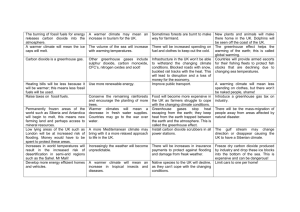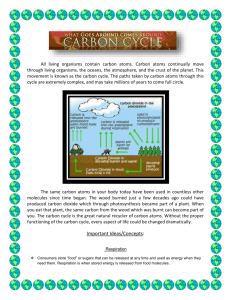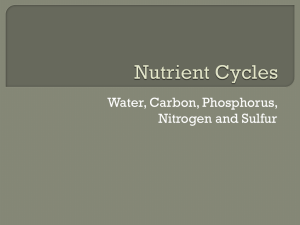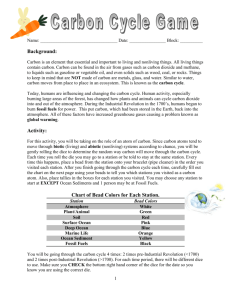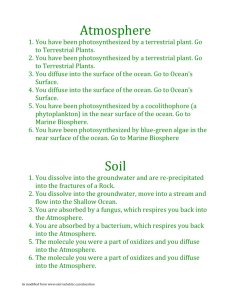Name: Date:______ Period:______ The Carbon Cycle and Global
advertisement
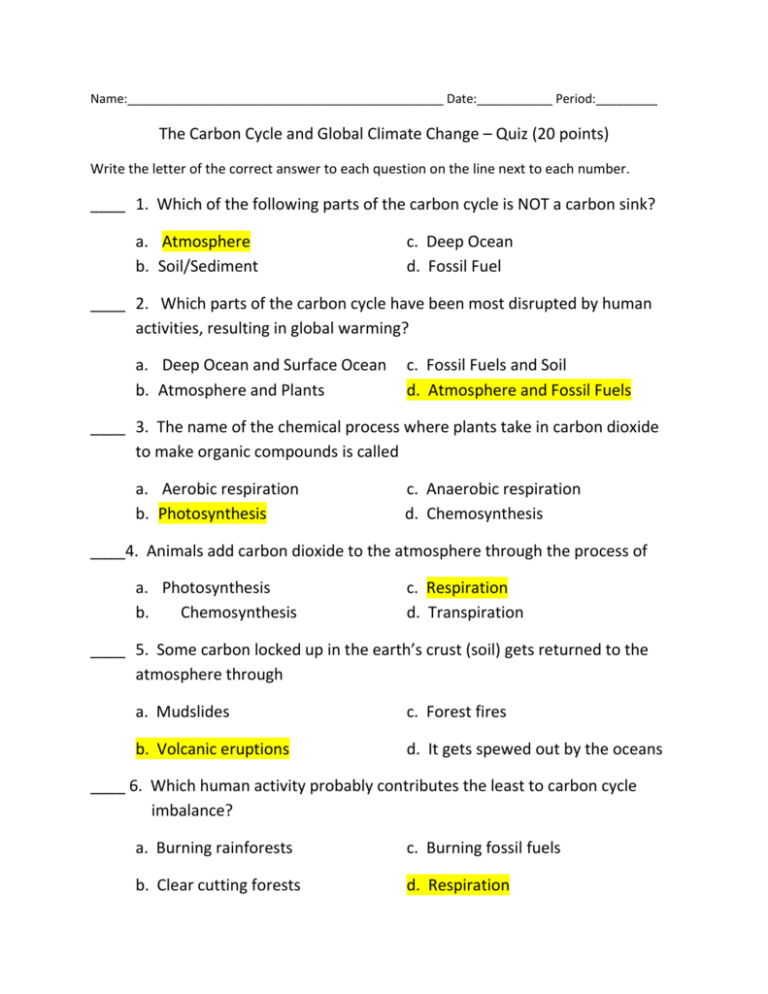
Name:______________________________________________ Date:___________ Period:_________ The Carbon Cycle and Global Climate Change – Quiz (20 points) Write the letter of the correct answer to each question on the line next to each number. ____ 1. Which of the following parts of the carbon cycle is NOT a carbon sink? a. Atmosphere b. Soil/Sediment c. Deep Ocean d. Fossil Fuel ____ 2. Which parts of the carbon cycle have been most disrupted by human activities, resulting in global warming? a. Deep Ocean and Surface Ocean b. Atmosphere and Plants c. Fossil Fuels and Soil d. Atmosphere and Fossil Fuels ____ 3. The name of the chemical process where plants take in carbon dioxide to make organic compounds is called a. Aerobic respiration b. Photosynthesis c. Anaerobic respiration d. Chemosynthesis ____4. Animals add carbon dioxide to the atmosphere through the process of a. Photosynthesis b. Chemosynthesis c. Respiration d. Transpiration ____ 5. Some carbon locked up in the earth’s crust (soil) gets returned to the atmosphere through a. Mudslides c. Forest fires b. Volcanic eruptions d. It gets spewed out by the oceans ____ 6. Which human activity probably contributes the least to carbon cycle imbalance? a. Burning rainforests c. Burning fossil fuels b. Clear cutting forests d. Respiration ____ 7. Human activities that have disrupted the carbon cycle have mostly occurred over the last 150 years, mainly a result of a. Increased logging c. Burning of the rainforests for agriculture b. The industrial revolution d. More people carrying on respiration ____ 8. Which part of the carbon cycle gives off the most carbon? a. Surface ocean c. Plants b. Burning fossil fuels d. Formation of sedimentary rock ____ 9. Which part of the carbon cycle gives off the least carbon? a. Burning fossil fuels c. Animal respiration b. Volcanic eruptions d. Plants ____ 10. The warming of the earth’s atmosphere by certain heat trapping gases is called? a. The quickening c. The greenhouse effect b. The Coriolis effect d. Ozone depletion ____ 11. The results of warming the earth’s atmosphere over the next 100 years include? a. Global climate change c. Drought b. A rise in ocean levels d. Flooding e. All of these will occur ____ 12. What are greenhouse gases? a. Gases in the atmosphere that trap heat b. Green-colored gases used to heat houses c. Gases produced inside greenhouses d. Gases produced by human activity that destroy the ozone layer ____ 13. What problems can warmer temperatures on earth cause? a. Coral reefs dying from warmer water temperatures b. Glaciers and polar ice caps melting, causing rising ocean levels c. Glaciers and polar ice melting, disrupting ocean currents and weather patterns d. Mass extinction as a result of changes environments e. All of these ____ 14. Which of the following will produce greenhouse gases? a. Solar Panels c. Windmills b. Nuclear power plants d. Coal burning power plants ____ 15. What can you do to counteract greenhouse gas accumulation? a. Plant trees and stop clearing forests b. Walk, ride a bicycle, and use mass transit instead of driving a car c. Use less manufactured products, and reuse or recycle as much as possible d. Use less electricity, and less heat in the winter e. All of these ____ 16. Why might it be bad for animals if earth warms? a. Their environments may change c. They will have to shed fur b. They will overheat d. Warmer is better for animals ____ 17. Why might it be bad for plants if earth warms? a. Warmer is better for plants c. They will overheat b. They won’t shed leaves d. Their environments may change ____ 18. Who will suffer the most from global climate change? a. The rich, industrial nations c. The poor, developing nations b. Only animals will suffer d. Only plants will suffer ____ 19. Who is most responsible for global warming? a. The rich, industrial nations c. The poor, developing nations b. Plankton (mircroscopic ocean life) d. Volcanoes ____ 20. Which country has surpassed the United States as the greatest producer of carbon dioxide emissions? a. Russia c. Australia b. Brazil d. China


